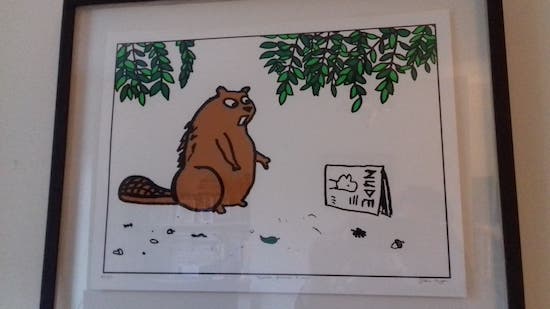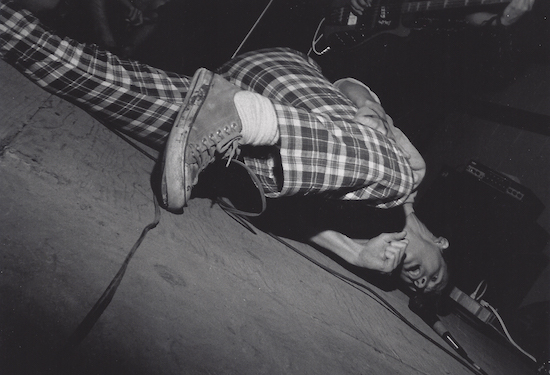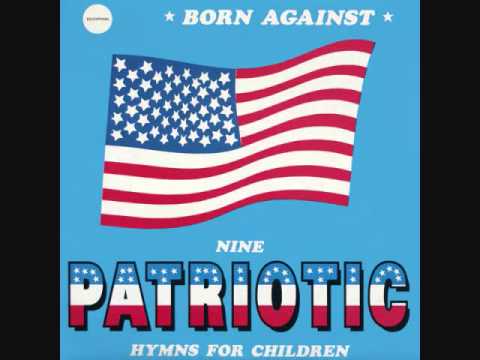Photo by Shawn Scallen
A quick paragraph for you to skip if you’re already aware of who Sam McPheeters(1) is. He fronted one band that received “a lot of attention within it’s circuit (Born Against)” and "two that did not (Men’s Recovery Project, Wrangler Brutes)”. He made fanzines(2). He ran Vermiform Records, home to his own bands and other heroic underground types such as Moss Icon, Heroin and Rorschach. He co-owned a record shop. He designed record sleeves and t-shirts and all the other things a DIY music character may design(3). If you were to ask me where to start with his discography I’d say Born Against’s Nine Patriotic Hymns from 1991(4). It’s almost 22 minutes of chaotic hardcore performed by a band who argued and ranted their way through four years (89-93) of existence. They Debated noted NYHC tough guys Sick Of It All on the radio regarding SOIA’s label In Effect self censoring to get records into the malls. They Flyered outside religious hardcore band Shelter’s nearby show(5) with printed zingers like “fuck religion”, making comparisons between the Krishna logo and the swastika. Generally doing what all decent punk rock bands should be doing, making you think, making you question, making you cringe on their behalf. Making you go home and think about starting a band. “I can do that”. Making you not start a band. “Why the hell would I want to do that”. He’s American. His favourite ever record is Age of Quarrel by the Cro-Mags, a band with Krishna connections. He’s a man with contradictions, self confessed contradictions. He last fronted a band in 2004. He’s been an author since, I recommend The Loom of Ruin. You are now up to speed.
In his book, a collection of thoughts and essays and critiques and interviews, McPheeters tours us through his 20 varied years in the world of punk. There’s a piece on Riot Grrrl, or more specifically The Casual Dots. How he learnt from it. About how no one in his social circle liked Bikini Kill, about how he was one of them and didn’t know why. No spoilers, you need to read it. Tobi Vail, Bikini Kill’s drummer, writes the foreword for the book (I guess this is a bit of a spolier). There’s a chapter where he visits the singer from The Crucifucks (Alternative Tentacles band from the 1980s) who changed his name to ’26’ and now lives in a boarded up house having antagonised everyone in his town, like a true punk. There’s a piece about a beautiful and dusty-eyed trip to the record pressing plant that pressed Vermiform’s releases as it’s being closed down. He has to collect all the parts(6) of the records he’s had pressed there before they get locked away and owned by lawyers. Due to living near to the plant he’s also charged with collecting the parts of a lot of friend’s labels (Jade Tree, Kill Rock Stars, Slap A Ham(7)). A historical place in California, 110 degrees when the presses start up. 55 years of pressing records and no major injuries unless you count the loss of three fingers as major.
He performs a splendid take down of the youth crew scene of the late 80s, specifically the band and arguably leaders of the scene, Youth of Today. Picking on the lyrics, comparing them to reworkings of the scout motto, slightly sinister, distantly tinged with fascism – “physically strong, morally straight, positive youth, we’re the youth of today!”. Picking on the fashion – varsity jackets and jumpers made by the sports brand Champion. But most impressively he picks on the font most of these bands used for band logos: “….fuck this font in the face. Collegiate-ass heavy line bullshit fratboy roofie typeface”. Included later on in the book there’s an interview he gave in 2010 for the book Touchable Sound: A Collection of 7” Records from the USA where he talks about sleeve design and art and how they work together. I would argue that MAYBE he’d agree that the "collegiate-ass heavy line" font used by Youth of Today and Gorilla Biscuits(8) and all the other clean cut youth crew bands was at the very least a successful branding ploy. You gotta love the prolonged hate though.
Amongst many other gems he also covers his depression, being briefly wealthy, interviewing Danzig, his preference for Muzak over pop music in shopping malls, the (masterfully excellent) band Die Kreuzen, the Germs film, disastrous tours, and what I assume is a career highlight: appearing in a Holly Valance pop video.
McPheeters style of writing is very smooth, it’s splendidly easy on the eye, it’s conversational and welcoming. He sees the joy of tucking into something wholeheartedly but is not afraid to pull it apart from the inside. The positives of the music, the negatives of scene politics (Maximum Rocknroll, Green Day, 924 Gilman Street all get discussed). He’s the first to admit when he’s gone wrong, he’s certainly gone wrong a few times – some words shouldn’t be used, some outfits not worn. He’s dismissive of his own punk rock history. He’s dismissive of his place in it yet he’s achieved more than most internet ranters will ever conjure up with “17 tours across the northern hemisphere”, his many notable Discogs entries and his joyous audience baiting.
I recommend this book. That’s a sentence a child would write to appease a teacher. I’m fine with that. It took me two days to read, and two more to go back over it to make sure. It’s written in a non self-aggrandising style. If you’re reading this then this book is for you. It’s for music lovers. It’s about his own experience living through a specific 20 years of mainly US hardcore punk(9), 1984-2004. A period that will be frozen in time for him, but there was a time before, there’s been time since, and there’s times to come. It’s argued that hardcore is a youth thing. Try telling that to me, aged 44, watching Warthog with 400 others at the Static Shock weekend in 2019. Or in the same venue as a 45 years old watching ASID or Muro this year and hopefully as a 46 year old next year watching the insanely good Greek band Antimob (hint, hint)(10).
[1] Throughout McPheeters’ book there are numbers like this. A classic and timeless referencing technique. Like a University paper or an educational book.
[2] After I’d first read the book I regretted not jumping back to the Endnotes section to follow the story there at the same time. I recommend when reading the book for the first time you do this, it really enhances the experience. His fanzines were called Wretched, Plain Truth, and Dear Jesus.
[3] See this piece of art on my friend Chris’ Nottingham based wall:

[4] I’m not kidding, this is a must own
[5] Is NY – Connecticut really “nearby” at 97 miles? Remember, Rollins worked in an ice cream place in DC and famously ‘popped’ down to NY to see Black Flag, sang their last song, and then ‘nipped’ back to DC to get back for work. “Nearby” means nothing in hilariously big countries.
[6] Master plates, artwork, sleeves, lacquers. All the bits and bobs a pressing plant needs to turn your rip roaring album into a physical thing for a shop to stock at initially full price. Then at a reduced price. Then eventually in the back room, alphabetically. Then randomly into a box with hundreds of other hopes and dreams and used as a doorstop. “The wind really blows through the shop, that damn door keeps banging, sort it out.”…….”Sorted”.
[7] Slap A Ham’s second release was an 8” Melvins flexi disc way back in 1990. This fact is always with me and I’ve never needed to have it stored in my head. Till now. And let’s be honest, I crowbarred it in.
[8] I have a soft spot for some of these bands, specifically Judge and Gorilla Biscuits, but I wasn’t there in New York when it was all happening. It’s easy to romanticize scenes through the power of endless books and documentaries. History is written by the winners. I’d loved to have seen Bad Brains in the early 80s or the Cro-Mags a few years later. The nightmarish tales of New York are part of the legend. I would have probably been into Foreigner and Loverboy and totally missed the whole thing. I’d re-write my history though and say I was there, CBGB matinees for Reagon Youth, down the front at the A7 for Agnostic Front, I was there man, changed my life.
[9] There is a chapter regarding the band Discharge from Slash’s hometown of Stoke-on-Trent.
[10] This is the end. Go buy the book. It’s published by Rare Bird Books. I got it from here.



